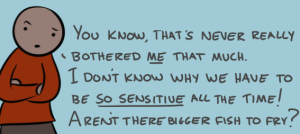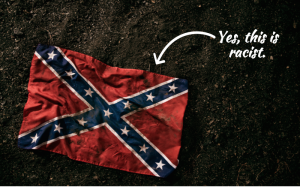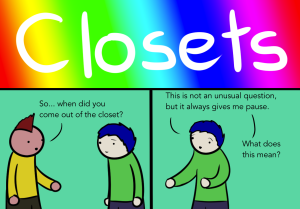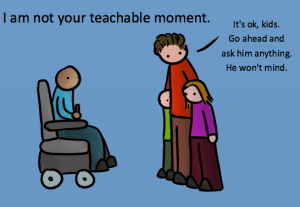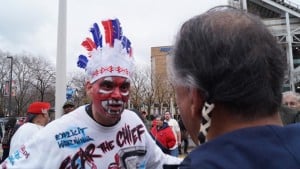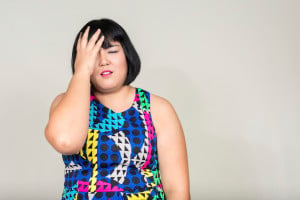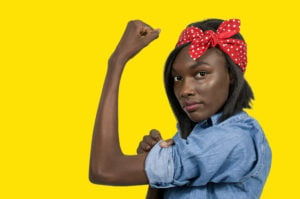
A person dressed as Rosie the Riveter against a yellow background.
Originally published on Resist Media and republished here with their permission.
In the aftermath of the 2016 election, a number of writers have pointed to white feminism as an answer to the question of how Trump became president.
White feminism, as an ideology and movement, has historically centered middle-class white women to the exclusion of poor women and women of color.
Thus, a number of women do not identify with feminism because they do not recognize themselves in white feminism.
I was one of those women who didn’t identify with feminism. It wasn’t that I didn’t believe in liberation for all genders. Rather, I didn’t see myself as part of a movement where no one looked like me.
Toward the end of my undergraduate years, I discovered the book Black Feminist Thought by Patricia Hill Collins, which helped me realized there were a number of alternatives to white feminism.
Educating oneself on feminism that centers women of color is important for recognizing how racism and sexism function together in intersecting forms of oppression.
As a Black feminist, I am most familiar with concepts by Black women scholars like bell hooks and Patricia Hill Collins.
To familiarize yourself with some of their work, check out this list of six concepts created by Black women intellectuals.
1. Controlling Images
Sociologist Patricia Hill Collins defines controlling images as the ideological dimension of the oppression of Black womanhood.
These images vary depending on historical and social context and generally characterize Black women in stereotypically negative ways.
Collins describes the emergence of these controlling images in her book, Black Feminist Thought: Knowledge, Consciousness, and the Politics of Empowerment.
In the quote below, she describes the development of the image of the “welfare queen” during the Reagan era:
With the election of the Reagan administration in 1980, the stigmatized welfare mother evolved into the more pernicious image of the welfare queen.
To mask the effects of cuts in government spending on social welfare programs that fed children, housed working families, assisted cities in maintaining roads, bridges, and basic infrastructure, and supported other basic public services, media images increasingly identified and blamed Black women for the deterioration of U.S. interests.
Thus, poor Black women simultaneously become symbols of what was deemed wrong with America and targets of social policies designed to shrink the government sector.
These controlling images can also influence how people treat Black women in their daily life.
In my own life, men have labeled me with the word “hoe” because they believe in the “Jezebel” stereotype controlling image of the hypersexual, promiscuous Black woman.
I and many other Black women had to deal with the way the endorsement of these beliefs affect self-esteem and self-image. To this day, controlling images of Black mothers and families influence policy, as this is negative stereotype is used to restrict all women’s rights.
2. Intersectionality
Kimberlé Crenshaw, executive director of the African American Policy Forum and Professor of Law at Columbia University, brought the concept of intersectionality to academia.
Intersectionality refers to how the interaction between different social categories (like race and gender) shape people’s lived experiences.
Intersectionality also refers to the complex way inequality is arranged at the societal level so that some groups have power relative to others, even if they are disadvantaged or privileged in other ways.
Crenshaw gives several examples of intersectionality in her landmark piece, “Mapping the Margins: Intersectionality, Identity Politics, and Violence Against Women of Color.”
For instance, laws meant to protect all women are most often created with white women in mind. Additionally, laws meant to protect Black people are most often created with men in mind.
However, when Black women attempt to seek legal protection in sex or race discrimination cases, they fail to meet the burden of proof because laws were not constructed with them in mind.
Intersectionality in the legal system would recognize that race and gender discrimination work together to shape the experiences of Black women.
3. Misogynoir
Black feminist scholar Moya Bailey coined the term misogynoir to describe the specific form of gendered racism experienced by Black women.
For example, misogynoir is at work when white women are praised for wearing styles created by Black women, who get called “ghetto” or “ratchet” for wearing the same fashions.
Misogynoir is an intersectional form of oppression in that Black women are subjected to it because their Blackness and womanhood are inseparable facets of their social identity.
4. Multiple Jeopardy
Often, when people speak on intersectionality, they are actually referring to multiple jeopardy, a term coined by sociologist Deborah K. King.
Multiple jeopardy refers to the inability to pinpoint any one factor as the most significant explanation for oppression.
In a 1988 article on the topic, King wrote:
The modifier “multiple” refers not only to several, simultaneous oppressions, but to the multiplicative relationships among them as well.
In other words, the equivalent formulation is racism multiplied by sexism multiplied by classism….
The importance of any one factor in explaining black women’s circumstances thus varies depending on the particular aspect of our lives under consideration and the reference groups to whom we are compared.
5. Womanism
Womanism, a term coined by poet and novelist Alice Walker, demonstrates that there are multiple forms of Black women’s feminism.
In a recent blog post, Alice Walker defined womanism as “the spiritual, political, social, and other empowerment based on female centrality and solidarity that is supportive of the health and well being of everyone.”
Her initial definition appeared in her 1983 collection of essays, In Search of Our Mothers’ Gardens, in which she defines a womanist as “a Black feminist or feminist of color” or “a woman who loves other women, sexually and/or non-sexually” through the celebration and affirmation of women’s culture, emotional flexibility, and strength.
6. Homeplace
Acclaimed feminist scholar bell hooks defines homeplace as “the one site where one could freely confront the issue of humanization, where one could resist.”
According to hooks, Black women across play a significant role in creating these spaces in their communities:
Despite the brutal reality of racial apartheid, of domination, one’s homeplace was the one site where one could freely confront the issue of humanization, where one could resist. Black women resisted by making homes where all Black people could strive to be subjects, not objects, where we could be affirmed in our minds and hearts despite poverty, hardship, and deprivation, where we could restore to ourselves the dignity denied us on the outside in the public world.
This particular concept demonstrates that women’s roles in the domestic sphere can be transformative and revolutionary.
What These Concepts Teach Us About Women of Color and Inequality
In my own life, these concepts helped me realize that Black women are actively changing how society describes and defines us.
Learning about controlling images helped me reject assumptions men made about sexuality. Understanding intersectionality helped me recognize that even though I face disadvantage as a Black woman, I have privilege as a person who is college-educated, cisgender, and Christian.
Lastly, learning about misogynoir helped me understand why society praises the Kardashians for their brazen sexuality, but disparages Amber Rose and Blac Chyna for theirs.
So, what action can you take as a person unfamiliar with these concepts?
- Educate yourself about the work of feminists of color. Click on the links above to find reading material. Check out the reference section of each piece for more!
- Make an effort to center women of color in your feminism. Recognize that cis and trans women of color have experienced lives that often differ from those of cisgender, middle-class white women.
- Figure out how these concepts apply in your own life. For instance, do you ever contribute to how controlling images affect Black women?
The aforementioned concepts describe the way that racism and sexism work together to disadvantage women of color. Beyond that, they also illustrate how Black women cope with and challenge the oppression they face.
For women of color, it isn’t about race alone or gender alone: Race and gender work together to affect our lived experiences.
These concepts teach us to be vigilant about whether feminist and anti-racist work and policies reflect all women, people of color, and everyone in between.
[do_widget id=’text-101′]
Melissa Brown is a PhD candidate in sociology. Her research examines how Black women use digital technology to enact social change. Melissa has written for news sites Huffington Post, Revelist, Gradient, and sociology blog Racism Review and Contexts. You can find more of Melissa’s writing at her personal blog or follow her on twitter @Blackfeminisms.
Search our 3000+ articles!
Read our articles about:
Our online racial justice training
Used by hundreds of universities, non-profits, and businesses.
Click to learn more






